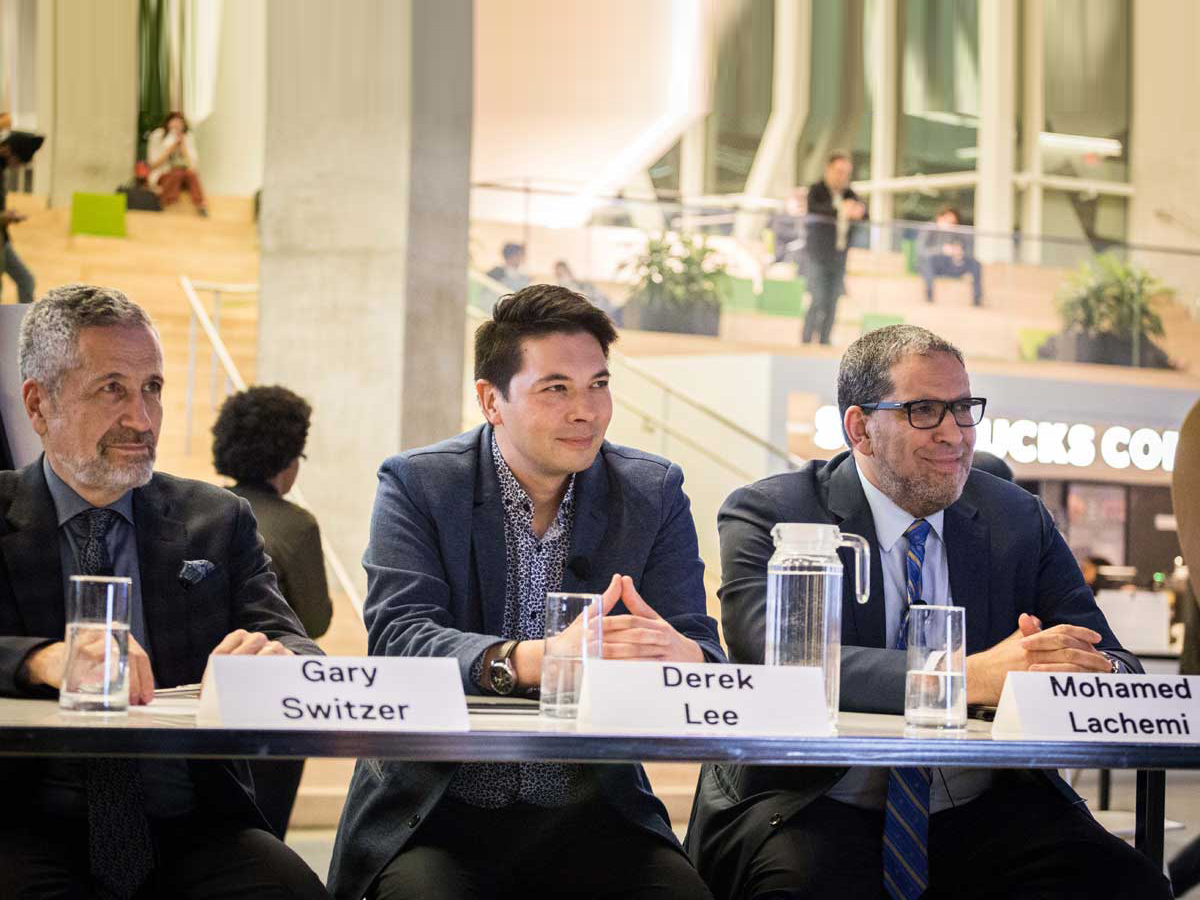The future of Yonge Street

Photo: MOD Developments CEO Gary Switzer, Vancouver-based developer Derek Lee, and Ryerson President Mohamed Lachemi took part in the February 22 event. Photo by Dominic Ali.
Could downtown Yonge Street become a pedestrian-only zone? The option met with broad approval on February 22, when Ryerson hosted a discussion on the neighbourhood’s future at the Student Learning Centre.
Organized by the Ryerson City Building Institute (opens in new window) in collaboration with the Downtown Yonge BIA (external link, opens in new window) ’s Yonge Love (external link) project, the event brought together prominent city-builders to discuss the future of Toronto’s busiest thoroughfare. Moderated by Steve Paikin, host of TVO’s The Agenda, the discussion was marked by general consensus on how Yonge Street could evolve.
“It should be big, it should be beautiful, it should be bold. We should not be timid in how we approach the reimagining of Yonge Street,” said Kristyn Wong-Tam, city councillor for Toronto Centre-Rosedale. “One of the challenges we’ve had in the city of Toronto is that we’ve been too timid.”
When Paikin asked if that meant the end of vehicle traffic, Wong-Tam said, “That’s certainly on the table, and certainly for parts of Yonge Street, and I don’t think there’s a reason why we shouldn’t do it. Especially since we know that the street functions in many different ways, through the seasons and during peak travel hours. … If there was a street to pedestrianize in the city of Toronto in a big, bold gesture, this is it.”
Jennifer Keesmaat, chief planner of the City of Toronto, encouraged a broader understanding of how the streets are used. She noted that on King Street, cars take up 64 per cent of the space, but only move 16 per cent of the users.
“Currently there are very narrow sidewalks but there are very high pedestrian volumes,” said Keesmaat. “We know that of the pedestrians on the street, 26 per cent are visiting the city. That’s a very high percentage of tourists that are along this corridor, and there’s an opportunity to beautify it, to enhance the public realm, and to redesign the right-of-way in such a way that it better accommodates the high volumes of pedestrians that exist on the corridor.”
Mark Garner, CEO and executive director of the Downtown Yonge BIA, said that this vision corresponds to the results of the BIA’s recent Yonge Love (external link) community consultation project. “It needs to be more walkable. It needs to be more pedestrian-friendly. We asked a lot of people what would be the big changes that you’d want to see, and [they said] obviously wider sidewalks, bike lane integration, and more pedestrian activity.” He suggested investigating options for a fully pedestrianized Yonge Street—either permanently or for weekend-only activations.
Ryerson University became a major force on Yonge Street with the opening of its Student Learning Centre in 2015. “We want to bring energy to Yonge Street,” said Ryerson President Mohamed Lachemi. “We have a community of 50,000 people coming here almost every day. Most of the people are commuters… We are not isolated from the city. We don’t have silos; we don’t have boundaries. We are part of the city, and Toronto is part of Ryerson.”
Gould Street on the Ryerson campus is currently the only fully pedestrianized street in the neighbourhood. “I would say it brings the community together,” said Lachemi. “For us, it’s the heart of our campus. We have a lot of activity for our students, but we also have a lot of activities for the rest of our community.”
There was question, however, of what Yonge Street’s growth will mean for its unique identity. As the rents rise, will Yonge Street simply become a venue for drug stores and banks? “There’s an opportunity here to do something big and bold and more than what we’re doing now, but it also means we have to get the development partners onside to aim for more and demand better from their own tenants,” said Wong-Tam.
The panel also featured insight from John Archer, chief development officer at 360 Collective; Derek Lee, partner at PWL Landscape Architects in Vancouver; Gary Switzer, CEO of MOD Developments; and Anjali Mishra, project manager of Roads and Transport Services for Montreal.